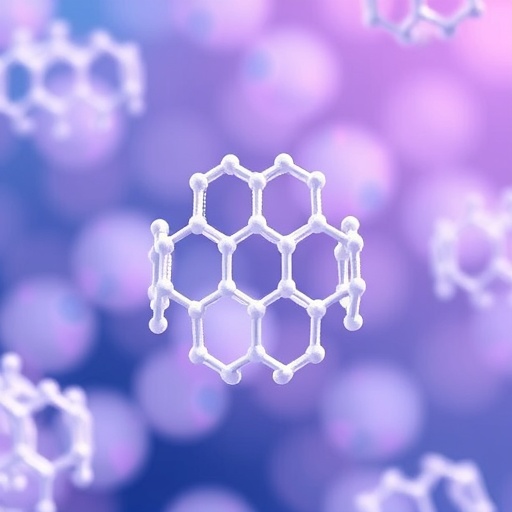In a groundbreaking advancement that promises to reshape the landscape of high-energy materials, researchers have successfully synthesized stable polymeric nitrogen at near ambient conditions through an innovative one-pot method. Led by Prof. Changqing Jin from the Beijing National Laboratory for Condensed Matter Physics at the Chinese Academy of Sciences, this pioneering study details the transformation of lithium azide precursors into a robust form of polymeric nitrogen known as atomic cubic gauche nitrogen (cg-N). Until now, the production of polymeric nitrogen—a material renowned for its immense energy storage capacity—required extreme pressures and harsh conditions, limiting practical applications. The novel ambient-pressure synthesis heralds a new era in material science, with far-reaching implications for energy storage and propellants.
The use of lithium azide as a precursor material is a strategic breakthrough that underlies the success of the ambient-condition synthesis route. Lithium azide, comprising lithium ions and azide anions, acts as both a nitrogen source and a facilitator for polymerization without the need for extreme pressure environments commonly employed in traditional methods. The “one-pot” synthetic strategy simplifies the chemical pathway by enabling the direct assembly of nitrogen atoms into the cg-N configuration in a single reaction vessel, reducing complexity and improving scalability. This innovative approach not only advances fundamental understanding but also presents practical avenues for cost-effective and sustainable production.
.adsslot_6MwevZdirY{width:728px !important;height:90px !important;}
@media(max-width:1199px){ .adsslot_6MwevZdirY{width:468px !important;height:60px !important;}
}
@media(max-width:767px){ .adsslot_6MwevZdirY{width:320px !important;height:50px !important;}
}
ADVERTISEMENT
A significant advantage of the one-pot synthesis lies in its ability to yield polymeric nitrogen with a higher mass content of the desired cg-N phase. This enhancement is largely attributed to the incorporation of lithium, the lightest metal element, into the final product matrix. Lithium’s presence not only boosts the purity and quantity of cg-N generated but also imparts unique physicochemical properties, including improved ignition characteristics. Lithium’s exceptional combustion heat of 42.94 kJ/g makes the material highly reactive and suitable for energetic applications, such as propellants and explosives, where controlled energy release is paramount.
Understanding the thermal stability of the newly synthesized polymeric nitrogen is crucial for conceptualizing its real-world applications. Thermal analyses reveal that upon heating, the cg-N material begins to decompose, releasing heat indicative of stored chemical energy. This thermally-induced decomposition underscores the metastable nature of polymeric nitrogen under ambient conditions, a trait desirable for high-energy-density materials that require stability during storage yet readily release energy upon activation. The thermal behavior showcased in this study provides important insights into the safety profiles and operational parameters needed for subsequent utilization.
Beyond fundamental research, this study’s implications extend towards the development of next-generation energetic materials. Polymeric nitrogen, with its inherently high chemical energy density, has long been postulated as a potential “green” alternative to conventional fuels and explosives due to its decomposition products primarily being nitrogen gas—a benign and abundant component of Earth’s atmosphere. The advancement in synthesizing cg-N under ambient conditions significantly lowers the barriers for industrial-scale production, positioning this polymeric nitrogen variant as an attractive candidate for practical deployment.
The integration of lithium within the polymeric nitrogen framework introduces complementary attributes that enhance material reactivity without compromising energy storage capabilities. Lithium’s well-documented ignition efficacy combined with polymeric nitrogen’s high energy density culminates in a composite capable of rapid and efficient energy release when triggered. This synergistic effect augments the material’s suitability for use in propulsion systems, pyrotechnics, and potentially in novel energy conversion technologies that benefit from on-demand high-energy-density sources.
A remarkable aspect of this research is its demonstration of a one-pot synthesis route that maintains ambient pressure and mild reaction conditions, which traditionally have been incompatible with achieving the cubic gauche structure of nitrogen. Many prior attempts necessitated megabar pressures or extreme temperatures, limiting reproducibility and scalability. By circumventing these challenges, this study not only furthers sustainable chemistry approaches but also simplifies synthetic workflows, thereby accelerating innovation and commercialization pathways in high energy materials.
The researchers also emphasize the importance of the cubic gauche nitrogen phase’s three-dimensional polymeric network of single N-N bonds, which differentiates it from molecular nitrogen forms characterized by strong triple bonds. This architectural nuance accounts for the instability inherent in nitrogen molecules and the potential energy stored in the polymeric form. Unlocking stable forms of covalently bonded nitrogen at low pressures has thus far eluded scientists, making this achievement a landmark in nitrogen chemistry and polymer science.
Future research inspired by this breakthrough may explore tuning the reaction parameters and precursor compositions to further enhance yield, stability, and performance of polymeric nitrogen materials. The potential to integrate additional metallic species or dopants to modulate ignition temperatures or energy release rates could open new frontiers in energetic material design. With sustainability and safety as guiding principles, the development of ambient pressure polymeric nitrogen could catalyze innovations across aerospace, defense, and renewable energy sectors.
The findings reported in this study, published in Science China Physics, Mechanics & Astronomy, underscore a decisive leap forward in the synthesis and application potential of polymeric nitrogen. They provide a compelling case for the reinvention of energetic materials through strategic chemical design and mild-condition science, transcending the limitations of previous high-pressure-dependent methodologies. Such advancements pave the way toward safer, more efficient, and environmentally benign energetic compounds poised to impact future technologies.
Subject of Research: Synthesis and characterization of stable atomic cubic gauche polymeric nitrogen (cg-N) at ambient pressure using lithium azide precursors.
Article Title: Atomic cubic gauche nitrogen polymerized at ambient pressure.
News Publication Date: 2025.
Web References:
http://dx.doi.org/10.1007/s11433-025-2690-9
References:
Eremets M. I. et al., Nat. Mater., 3, 558 (2004)
Caracas R. et al., J. Chem. Phys., 127, 14451053 (2007)
Image Credits: ©Science China Press
Keywords
Polymeric nitrogen, cubic gauche nitrogen, lithium azide, Raman spectroscopy, high-energy-density materials, one-pot synthesis, ambient pressure synthesis, thermal stability, energetic materials, nitrogen polymerization, lithium combustion, covalent nitrogen networks
Tags: ambient pressure nitrogen productionbreakthroughs in polymeric materialscubic gauche nitrogen structureenergy density of nitrogen compoundshigh-energy materials researchimplications for propellant technologyinnovative material synthesis methodslithium azide transformationpolymeric nitrogen energy storageRaman spectroscopy in material sciencestable cubic nitrogen synthesissynthesis of polymeric nitrogen





